[Editor’s Note: One of Army Mad Scientists’ missions is to harness its community of action to help the Army imagine future possibilities. Today’s post by guest blogger LTC Steve Speece effectively accomplishes this with a series of five illustrated vignettes, peering into the mid-twenty-first century and exploring what the Operational Environment (OE) could hold for future conflicts. Deftly weaving compelling narrative and awesome graphics with evocative themes — attrition warfare and stalemate in the space domain; commercial letters of marque and a return to high seas privateering; great power competition via proxy warfare in distant lands; the role of integrated sensors in dense urban environments; and enhanced longevity via genetic engineering versus immortality via artificial intelligence avatars — LTC Speece provides our readers with provocative insights into deep future OE possibilities. Read on!]
Kourou Space Centre, French Guiana
October 2049
 The rapid payload integration center crew watched as the three reusable rocket boosters landed nearly simultaneously across from the refurbish-assembly building. Fantails of chemical foam
The rapid payload integration center crew watched as the three reusable rocket boosters landed nearly simultaneously across from the refurbish-assembly building. Fantails of chemical foam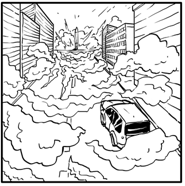 erupted from un-manned ground vehicles and a mobile recovery crane lurched toward the scene. The launch operations center director, Alex,
erupted from un-manned ground vehicles and a mobile recovery crane lurched toward the scene. The launch operations center director, Alex, 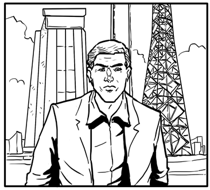 rubbed the temples of his balding head. This was a record fast turnaround for reusable boosters for them. Brussels was asking his team to repeat this feat two more times.
rubbed the temples of his balding head. This was a record fast turnaround for reusable boosters for them. Brussels was asking his team to repeat this feat two more times.
Why the urgency? A serial of networked Chinese satellites was drifting towards a protected communications satellite, one of the few the European Union had in operation. It was a high value asset. Alex has been launching autonomous blocking satellites to interdict the potential threats. He stepped out of the franticly busy refurbishment bay for a breath of fresh air. A rooster clucked as it walked by.
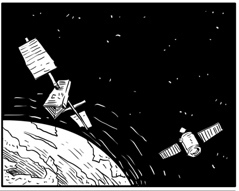 This was a key wartime effort. The conflict in space began about six years ago among the expected belligerents. No one seemed surprised that it started. What surprised everyone is how tediously slow it unfolded and that it is still dragging on six years later. War in space was not the decisive catastrophe of Kessler Syndrome debris the world expected. It was an expensive war of attrition.
This was a key wartime effort. The conflict in space began about six years ago among the expected belligerents. No one seemed surprised that it started. What surprised everyone is how tediously slow it unfolded and that it is still dragging on six years later. War in space was not the decisive catastrophe of Kessler Syndrome debris the world expected. It was an expensive war of attrition.
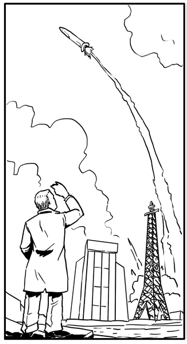 It had more in common with the positional trench warfare of the First World War than 20th century science fiction. One of Alex’s ancestors fought in World War I, and now he serves as an officer in the French Space Force. Alex sees satellites launched to block other satellites to block other satellites in seemingly infinite recursion. Some orbital regimes were now so densely occupied that some of Alex’s handiwork was visible from Earth. In the late evening he could already see the milky band across the sky that was the geo belt.
It had more in common with the positional trench warfare of the First World War than 20th century science fiction. One of Alex’s ancestors fought in World War I, and now he serves as an officer in the French Space Force. Alex sees satellites launched to block other satellites to block other satellites in seemingly infinite recursion. Some orbital regimes were now so densely occupied that some of Alex’s handiwork was visible from Earth. In the late evening he could already see the milky band across the sky that was the geo belt. 
It all reminded him of the 1914 Race to the Sea, culminating in years of trench warfare he learned about in school.
He knew this kind of warfare would have no winners. In the distance he saw a large autonomous merchant vessel pull into Port Kourou to unload shipping containers full of satellite hardware for him to integrate into payload racks.
100 Nautical Miles South of Seychelles, Indian Ocean
June 2050
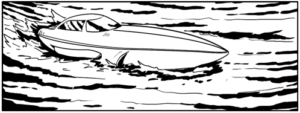 The low-profile semi-submersibles slipped out of the well deck of the converted bulk cargo ship under cloud cover and sliced through white caps towards the shipping lane. The Chinese task force charged with this zone was stretched thin, attempting to counter privateers, “flying circus” air raids from Australia, and policing embargo violations from the Americas. Darren piloted the lead semi-submersible in the small privateer wolfpack of six boats. They will rely on speed and stealth to make it to and from
The low-profile semi-submersibles slipped out of the well deck of the converted bulk cargo ship under cloud cover and sliced through white caps towards the shipping lane. The Chinese task force charged with this zone was stretched thin, attempting to counter privateers, “flying circus” air raids from Australia, and policing embargo violations from the Americas. Darren piloted the lead semi-submersible in the small privateer wolfpack of six boats. They will rely on speed and stealth to make it to and from  the target area while avoiding detection. Soon the wolfpack came into primary sensor range of two massive autonomous merchant vessels heading outbound from East Africa towards Indochina. Darren launched a small, expendable, multi-rotor drone from a tube into the sky and the display in front of him opened up a video feed.
the target area while avoiding detection. Soon the wolfpack came into primary sensor range of two massive autonomous merchant vessels heading outbound from East Africa towards Indochina. Darren launched a small, expendable, multi-rotor drone from a tube into the sky and the display in front of him opened up a video feed.
He captured still images of the vessel names. “We have positive identification,” he said. The wolfpack split into two formations, one of which peeled away to the Southeast. Once on their target marks,  each semi-submersible deployed their large slow-moving torpedo mines. The wolfpack then dispersed to make their way back to their mothership independently to confound post-strike analysis by the Artificial Intelligences which would certainly begin hunting for their signatures. If detained, they will be charged with piracy, and very possibly executed. Some of the privateers have embraced the pirate identity, despite the danger.
each semi-submersible deployed their large slow-moving torpedo mines. The wolfpack then dispersed to make their way back to their mothership independently to confound post-strike analysis by the Artificial Intelligences which would certainly begin hunting for their signatures. If detained, they will be charged with piracy, and very possibly executed. Some of the privateers have embraced the pirate identity, despite the danger.
One after another, explosions ripped through the hulls of the two autonomous merchant vessels and the northernmost one began to list. Sinking commercial ships of these tonnages could take hours or even days, but that was not necessarily the objective of the raid. Darren’s wolfpack was not targeting the ships themselves, or even the rare earth metal ores they were carrying.
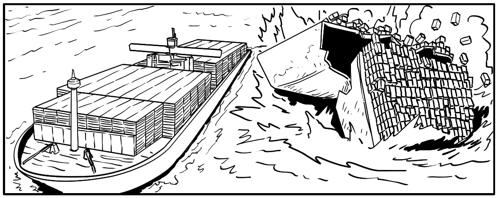
The objective was the thousands of containers now toppling into the Indian Ocean as the ships capsized. Depriving Beijing of these containers would wreak havoc on supply chains and holding up transport of everything passing through intermodal facilities on the maritime silk road. Of course, it would be easy to build more shipping containers but that would take time at great opportunity cost, all the while Darren’s wolfpack would continue its campaign financed by a nameless oligarch with a bottomless bank account.
On the deck of the second damaged and listing merchant, a blue container opened its roof hatch to reveal a concealed bank of cruise missiles. Two missile canisters began raising to their launch positions but before they could fire, the container slipped off the listing ship and plunged into the ocean. Darren was fortunate. He started doing the math in his head. His synthetic-stock in the cryptographic letter-of-marque to be redeemed by his private security broker should be enough for him to finally pay off his mortgage.
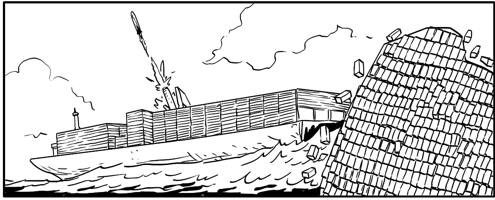
Madang, Papua New Guinea
September 2051
 John pressed up against the fence to watch the two unmanned refuelers taxi down the runway and quickly pull into makeshift hardened aircraft shelters on the apron. The great powers are fighting a regional proxy war to the west. Chinese-backed separatists are fighting an insurgency against the Western-supported Jakarta government. Beijing has imposed a no-fly-zone over much of the Indonesian archipelago to give sanctuary to insurgents in Borneo and Sulawesi.
John pressed up against the fence to watch the two unmanned refuelers taxi down the runway and quickly pull into makeshift hardened aircraft shelters on the apron. The great powers are fighting a regional proxy war to the west. Chinese-backed separatists are fighting an insurgency against the Western-supported Jakarta government. Beijing has imposed a no-fly-zone over much of the Indonesian archipelago to give sanctuary to insurgents in Borneo and Sulawesi.
John occasionally sees the sleek silhouettes of Chinese fighters and surveillance drones in the sky from the boat harbor. The Royal Australian Air Force and its allies did not have the numbers to challenge China’s air power everywhere. Instead they mass their few exquisite capabilities in time and space to dominate a specific area for a while before Chinese forces can respond decisively. The Australians called the forces deployed in asymmetric strategy the “Flying Circus” after the historic predecessor. When the Flying Circus came to town, it put on a significant event for the locals. They brought more than aircraft and missiles; they brought containers full of cargo.
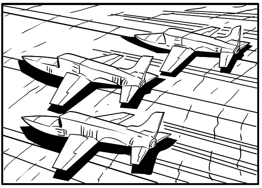 Advanced allied strike aircraft would land in short order, quickly rearm, refuel, and sortie on mission. They would attack enemy aircraft, insurgent missile batteries, and merchant ships full of shipping containers. Those containers would occasionally wash ashore or be towed in by fishing boats to be plundered.
Advanced allied strike aircraft would land in short order, quickly rearm, refuel, and sortie on mission. They would attack enemy aircraft, insurgent missile batteries, and merchant ships full of shipping containers. Those containers would occasionally wash ashore or be towed in by fishing boats to be plundered.
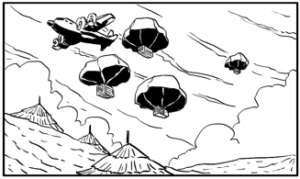 John’s ancestors worshipped cargo. During the Second World War, his people witnessed cargo airdropped off course and took it for blessings from the gods. Now, of course, most people know exactly where cargo comes from. But the cargo
John’s ancestors worshipped cargo. During the Second World War, his people witnessed cargo airdropped off course and took it for blessings from the gods. Now, of course, most people know exactly where cargo comes from. But the cargo  faith is about more than just shipping containers. The return of the importance of cargo to the lives of people in his community has led to a renaissance of the folk religion. Like their ancestors before them, the people in John’s community built makeshift airfields inland from the real one. They built life-size replicas of advanced American fighters out of bamboo, scrap metal, and
faith is about more than just shipping containers. The return of the importance of cargo to the lives of people in his community has led to a renaissance of the folk religion. Like their ancestors before them, the people in John’s community built makeshift airfields inland from the real one. They built life-size replicas of advanced American fighters out of bamboo, scrap metal, and  fiberglass siding. Maybe this was partly a sincere religious tradition and partly a practical matter to convince the Flying Circus it was safe to return.
fiberglass siding. Maybe this was partly a sincere religious tradition and partly a practical matter to convince the Flying Circus it was safe to return.
When the composite squadron of fighters and drones finally sortied loaded with missiles, John left the area near the airfield. He knew it was not safe yet. He made his way to the top of a large hill overlooking Madang. It was evening and he saw the faint glowing tail of a satellite burning up on reentry in the distance. This one was strange; it kept glowing and turned in a wide arc. This was in fact a hypersonic glide vehicle and it began to leave a thick vapor trail behind it as it turned and plunged toward the earth– detonating on the ritual replica airfield.
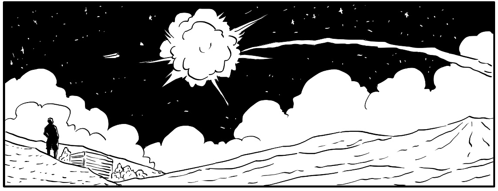
Dar es Salaam, Tanzania
March 2052
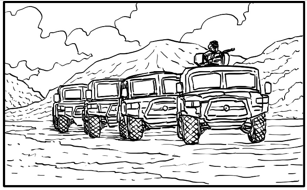 The massive armored vehicle rolled to a stop and the rear hatch opened to a dark and quiet neighborhood. Feng is a PLA Soldier on a four-month rotation to Tanzania. There is fighting and violence, but little of that for him to do. Feng spends most of his time maintaining the expansive network of sensor and communications towers
The massive armored vehicle rolled to a stop and the rear hatch opened to a dark and quiet neighborhood. Feng is a PLA Soldier on a four-month rotation to Tanzania. There is fighting and violence, but little of that for him to do. Feng spends most of his time maintaining the expansive network of sensor and communications towers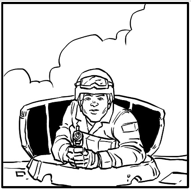 in the sprawling urban area. Satellite communication was no longer cost effective or reliable in this part of the world. The towers which combine public data services, security monitoring, and secure networking for unmanned combat vehicles have proven an effective and lethal counter to the New Islamic State.
in the sprawling urban area. Satellite communication was no longer cost effective or reliable in this part of the world. The towers which combine public data services, security monitoring, and secure networking for unmanned combat vehicles have proven an effective and lethal counter to the New Islamic State.
The problem is that NIS combatants have begun to take the towers offline faster than Feng and his unit can repair them. He looked up at the 100-meter  tower bristling with polygonal antennas and began walking towards the gated perimeter warning lights. The air smelled of burnt plastic and raw sewage. Feng’s section chief remained in the vehicle to provide security. He extended the armored vehicle’s sensor mast and began scanning rooflines, looking for indicators that they were being watched. There were at least three insurgent groups active in this area.
tower bristling with polygonal antennas and began walking towards the gated perimeter warning lights. The air smelled of burnt plastic and raw sewage. Feng’s section chief remained in the vehicle to provide security. He extended the armored vehicle’s sensor mast and began scanning rooflines, looking for indicators that they were being watched. There were at least three insurgent groups active in this area.
 Feng did not make it to the gate before the explosives detonated in a carefully hidden tunnel under one of the tower’s massive steel legs. Upheaved earth
Feng did not make it to the gate before the explosives detonated in a carefully hidden tunnel under one of the tower’s massive steel legs. Upheaved earth 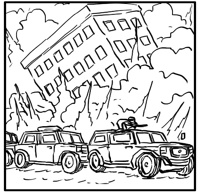 surged into the air and landed in a cloud of debris. The structure groaned and began to topple, slowly at first and then rapidly– collapsing to the ground.
surged into the air and landed in a cloud of debris. The structure groaned and began to topple, slowly at first and then rapidly– collapsing to the ground.
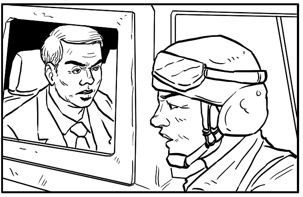 The Chinese Soldier quickly grabbed his bag of tools and ran back to the waiting armored vehicle. There in the vehicle he jumped into the remote weapons station and assured his chief he was okay.
The Chinese Soldier quickly grabbed his bag of tools and ran back to the waiting armored vehicle. There in the vehicle he jumped into the remote weapons station and assured his chief he was okay.
The all-domain combat vehicle had a suite of defensive measures to protect them against missiles, remotely piloted aircraft, or even directed energy weapons. However, without connectivity to the secure area network they could only rely on their own vehicle’s sensors. A crowd of civilians began to gather near the toppled tower, maybe a threat, or maybe just looters looking for scrap. The rare earth metals in those antennas alone were probably worth several times what the locals earned in a year. Ironically, much of it was mined just a few kilometers inland, shipped across the Indian Ocean to be refined and manufactured into electronics and shipped back to Tanzania.
The situational awareness display showed several icons representing autonomous combat vehicles in motion. “Let’s go,” said the Chief, and the vehicle’s electric motors began to whine into action. Feng swiveled the sensor ball around to watch the growing crowd of armed civilians as they drove away. An older man and a boy unraveled the unmistakable banner of the New Islamic State.

Beijing, People’s Republic of China
June 2053
In two days, the President and Chairman of the Central Military Commission would celebrate his 100th birthday. He is showing no signs of slowing down.

The Chairman kept the specific protocol of his longevity treatments a guarded state secret, but it was obvious his therapy treatments were state-of-the-art. Most of the Chinese Communist Party senior leaders expected him to remain alive and in office for at least another fifty years and few expected to outlive 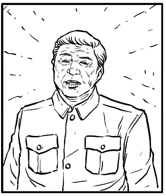 him. Beijing has now officially banned superlongevity treatments within China, but the Chairman and other Chinese elites continue to seek it out surreptitiously. Publicly, Beijing authorities express grave concern about superlongevity technology from the West which allows the wealthy to accumulate even larger fortunes over multiple natural human lifetimes.
him. Beijing has now officially banned superlongevity treatments within China, but the Chairman and other Chinese elites continue to seek it out surreptitiously. Publicly, Beijing authorities express grave concern about superlongevity technology from the West which allows the wealthy to accumulate even larger fortunes over multiple natural human lifetimes.
The Chairman has now for decades perceived the rise of private wealth among the world’s semi-stateless trillionaire oligarchs as a competing center of power. Beijing has not seen a peaceful transfer of power in over 40 years. Over the decades, the Chairman had accumulated enemies big and small and carries with him the diplomatic baggage of failed foreign policies and broken promises.
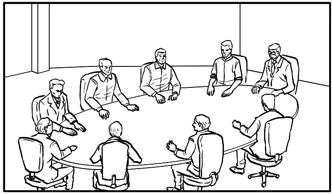 The Central Military Commission members sat around an elegant circular wooden conference table. They all began their rehearsed performance for the videographer/historian from the state-controlled media, the committee listening intently to the Chairman’s lecture. The scene was captured and the videographer left the committee to its real work– the operation to kill the so-called Caliph of the New Islamic State.
The Central Military Commission members sat around an elegant circular wooden conference table. They all began their rehearsed performance for the videographer/historian from the state-controlled media, the committee listening intently to the Chairman’s lecture. The scene was captured and the videographer left the committee to its real work– the operation to kill the so-called Caliph of the New Islamic State.
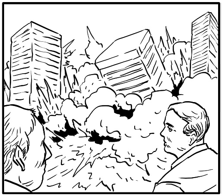 The New Islamic State was notoriously responsible for the port explosion that killed over 10,000 in Shanghai. Much like the old Islamic State, for some Wahhabi Muslims, the mere existence of a credible Caliph with formal control over territory activated tenets of Islamic Law which lay dormant for hundreds of years.
The New Islamic State was notoriously responsible for the port explosion that killed over 10,000 in Shanghai. Much like the old Islamic State, for some Wahhabi Muslims, the mere existence of a credible Caliph with formal control over territory activated tenets of Islamic Law which lay dormant for hundreds of years.
 Beijing’s strategic manhunt aimed to eliminate the Caliph and revert the ideology of that demographic back to its peaceful state. The human who was the physical Caliph was killed ten years ago outside a religious school in Pakistan.
Beijing’s strategic manhunt aimed to eliminate the Caliph and revert the ideology of that demographic back to its peaceful state. The human who was the physical Caliph was killed ten years ago outside a religious school in Pakistan.
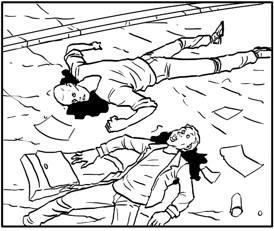 The Caliph speaking in the video clip in front of them today was an artificial intelligence trained on the writings and speeches of the original. It was an avatar, a replica, and maybe to some– a hoax. But to enough people this Caliph was real. Beijing just simultaneously struck three data centers in Indonesia and Africa and killed software developers believed to be critical vulnerabilities to the operation of the AI.
The Caliph speaking in the video clip in front of them today was an artificial intelligence trained on the writings and speeches of the original. It was an avatar, a replica, and maybe to some– a hoax. But to enough people this Caliph was real. Beijing just simultaneously struck three data centers in Indonesia and Africa and killed software developers believed to be critical vulnerabilities to the operation of the AI.
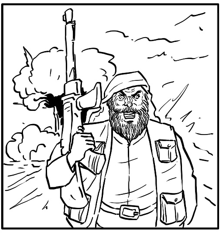
Despite operational reports claiming success, the Caliph has returned once again.
There he was on the screen calling for new attacks. He is effectively immortal.
If you enjoyed this post, check out the following content on the future OE:
The Future Operational Environment: The Four Worlds of 2035-2050, the complete AFC Pamphlet 525-2, Future Operational Environment: Forging the Future in an Uncertain World 2035-2050, and associated video
Weighing Effort in the Future Strategic Environment 2028-2035, by MAJ James P. Micciche and CW3 Nick Rife
… as well as the following related content:
Space: Challenges and Opportunities; Star Wars 2050, by proclaimed Mad Scientist Marie Murphy; and Space 2035: A Surplus of Uncertainty and a Deficit of Trust, by Maj Rachel Reynolds
Unleash the Privateers! by Colonel Mark Cancian (USMC-Ret.) and Brandon Schwartz, in our colleagues’ at the USNI journal Proceedings; Insights from the Robotics and Autonomy Series of Virtual Events; Pattern Detected! Masking by Injecting Randomness, by Chris Butler; Disrupting the “Chinese Dream” – Eight Insights on how to win the Competition with China; and Competition and Conflict in the Next Decade
For a discussion on exquisite capabilities, see “Once More unto The Breach Dear Friends”: From English Longbows to Azerbaijani Drones, Army Modernization STILL Means More than Materiel, by Ian Sullivan. For more on battlefield transparency, masking, and deception, see Top Attack: Lessons Learned from the Second Nagorno-Karabakh War, its associated podcast, Nowhere to Hide: Information Exploitation and Sanitization, and War Laid Bare, by Matthew Ader
New Skills Required to Compete & Win in the Future Operational Environment; Warfare in the Parallel Cambrian Age, by Chris O’Connor; Character of Warfare 2035; The Future of War is Cyber! by CPT Casey Igo and CPT Christian Turley; Military Implications of Smart Cities, by Alexander Braszko, Jr.; and Integrated Sensors: The Critical Element in Future Complex Environment Warfare, by Dr. Richard Nabors
Designer Genes: Made in China? by proclaimed Mad Scientist Dr. James Giordano and Joseph DeFranco; The Technological Information Landscape: Realities on the Horizon, by Dr. Lydia Kostopoulos; The Death of Authenticity: New Era Information Warfare; Influence at Machine Speed: The Coming of AI-Powered Propaganda, by MAJ Chris Telley; The Exploitation of our Biases through Improved Technology, by proclaimed Mad Scientist Raechel Melling; and Insights from the Mad Scientist Weaponized Information Series of Virtual Events
… and see CPT Katherine Hathaway‘s winning entry to last Summer’s CALLING ALL CREATORS ~ An Army Mad Scientist Multi-Media Contest, entitled Kryptós, showcasing her ideas about future OE possibilities in an imaginative, alternative way.
>>> REMINDER: Army Mad Scientist Fall / Winter Writing Contest: Crowdsourcing is an effective tool 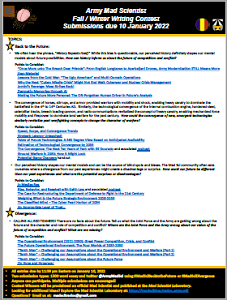 for harvesting ideas, thoughts, and concepts from a wide variety of interested individuals, helping to diversify thought and challenge conventional assumptions. Army Mad Scientist seeks to crowdsource the intellect of the Nation (You!) with our Fall / Winter Writing Contest’s two themes — Back to the Future and Divergence – check out the associated writing prompts in the contest flyer and announcement, then get busy crafting your submissions — entries will be accepted in two formats:
for harvesting ideas, thoughts, and concepts from a wide variety of interested individuals, helping to diversify thought and challenge conventional assumptions. Army Mad Scientist seeks to crowdsource the intellect of the Nation (You!) with our Fall / Winter Writing Contest’s two themes — Back to the Future and Divergence – check out the associated writing prompts in the contest flyer and announcement, then get busy crafting your submissions — entries will be accepted in two formats:
Written essay (no more than 1500 words, please!)
Tweet @ArmyMadSci, using either #MadSciBacktotheFuture or #MadSciDivergence
We will pick a winner from each of these two formats!
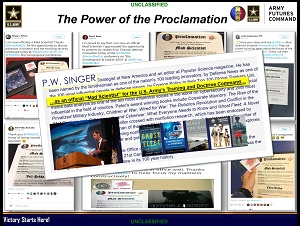 Contest Winners will be proclaimed official Mad Scientists and be featured in the Mad Scientist Laboratory. Semi-finalists of merit will also be published!
Contest Winners will be proclaimed official Mad Scientists and be featured in the Mad Scientist Laboratory. Semi-finalists of merit will also be published!
DEADLINE: All entries are due NLT 11:59 pm Eastern on January 10, 2022!
Any questions? Don’t hesitate to reach out to us — send us an eMail at: madscitradoc@gmail.com
Steve Speece is an active duty U.S. Army officer currently assigned to the Joint Staff J2 as an Executive Intelligence Briefer to the Chairman’s Special Staff.
Disclaimer: The views expressed in this blog post do not necessarily reflect those of the Department of Defense, the Joint Staff, Defense Intelligence Agency, Department of the Army, Army Futures Command (AFC), or U.S. Army Training and Doctrine Command (TRADOC).



